Calibration of a Low-Cost 8×8 Active Phased Array Antenna
Abstract
:1. Introduction
2. Architecture of the Active Phased Array Antenna
2.1. Antenna Design
2.2. Antenna Power and Control Systems
3. Active Phased Array Calibration
3.1. Passive Antenna Measurement
- A.
- Since the connector has a certain bend, it may be that the End Launch connector is not directly in the center of the feeding microstrip line of the columns.
- B.
- In the process of adhesive bonding of the PCBs, the alignment is not very precise and, when pressing the PCBs, the heights of the prepreg and foam were affected, differing from the height of the simulation.
3.2. Active Antenna Measurement
- The amplitude and phase control of the column under test are programmed to behave with maximum gain state and zero-state for the phase.
- The rest of the channels are disabled with the amplitude control set to maximum attenuation state (30 dB).
- The S21 parameter between the SGH and the column under test is measured. For each measurement, a frequency sweep for 17.7 GHz to 20.2 GHz is measured for each column.
4. Measurement Comparison
5. Conclusions
Author Contributions
Funding
Data Availability Statement
Acknowledgments
Conflicts of Interest
References
- Corici, M.; Liolis, K.; Politis, C.; Geurtz, A.; Cahill, J.; Bunyan, S.; Schlichter, T.; Völk, F.; Kapovits, A. Satellite Is 5G—SATis5 Whitepaper. Available online: https://connectivity.esa.int/sites/default/files/Satellite%20is%205G%20-%20SATis5%20Whitepaper.pdf (accessed on 6 July 2024).
- Jung, Y.-B.; Eom, S.-Y.; Jeon, S.-I. Novel Antenna System Design for Satellite Mobile Multimedia Service. IEEE Trans. Veh. Technol. 2010, 59, 4237–4247. [Google Scholar] [CrossRef]
- Ding, R.; Chen, T.; Liu, L.; Zheng, Z.; Hao, Y.; Zheng, H.; Wang, W.; You, L. 5G Integrated Satellite Communication Systems: Architectures, Air Interface, and Standardization. In Proceedings of the 2020 International Conference on Wireless Communications and Signal Processing (WCSP), Nanjing, China, 21–23 October 2020; pp. 702–707. [Google Scholar]
- Jacomb-Hood, A.; Lier, E. Multibeam active phased arrays for communications satellites. IEEE Microw. Mag. 2000, 1, 40–47. [Google Scholar] [CrossRef]
- Khalily, M.; Tafazolli, R.; Xiao, P.; Kishk, A.A. Broadband mm-Wave Microstrip Array Antenna With Improved Radiation Characteristics for Different 5G Applications. IEEE Trans. Antennas Propag. 2018, 66, 4641–4647. [Google Scholar] [CrossRef]
- Muriel-Barrado, A.T.; Calatayud-Maeso, J.; Rodriguez-Gallego, A.; Sanchez-Olivares, P.; Fernandez-Gonzalez, J.M.; Sierra-Perez, M. Evaluation of a Planar Reconfigurable Phased Array Antenna Driven by a Multi-Channel Beamforming Module at Ka Band. IEEE Access 2021, 9, 63752–63766. [Google Scholar] [CrossRef]
- Sun, X.; Calatayud-Maeso, J.; Muriel-Barrado, A.-T.; Sanchez-Olivares, P.; Gonzalez, J.M.F. Low Cost Active Phased Array with Switchable Circular Polarization in Ka Band for SATCOM Application. In Proceedings of the 2022 16th European Conference on Antennas and Propagation (EuCAP), Madrid, Spain, 27 March–1 April 2022; pp. 1–5. [Google Scholar]
- Low, K.K.W.; Kanar, T.; Zihir, S.; Rebeiz, G.M. A 17.7–20.2-GHz 1024-Element K-Band SATCOM Phased-Array Receiver With 8.1-dB/K G/T, ±70° Beam Scanning, and High Transmit Isolation. IEEE Trans. Microw. Theory Tech. 2022, 70, 1769–1778. [Google Scholar] [CrossRef]
- 9. Jiang, H.; Qian, M.; Liao, S.; Xue, Q. A 17.7-21.2 GHz Antenna Element for SATCOM Phased-Array Receiver. In Proceedings of the 2024 15th Global Symposium on Millimeter-Waves & Terahertz (GSMM), Hong Kong, 20–22 May 2024; pp. 61–63. [Google Scholar]
- Hu, Z.; Li, L.; Kazan, O.; Rebeiz, G.M. A 16-Channel 3.1–25.5-GHz Phased-Array Receive Beamformer IC With Two Simultaneous Beams and 2.0–2.4-dB NF for C/X/Ku/Ka-Band SATCOM. IEEE Trans. Microw. Theory Tech. 2024, 72, 2773–2785. [Google Scholar] [CrossRef]
- Luo, X.; Ouyang, J.; Chen, Z.; Han, L.; Yan, W. A Low-Profile 36-Element K-Band Active Phased Array for Ultra-Small Aperture Application. IEEE Access 2020, 8, 62286–62297. [Google Scholar] [CrossRef]
- Song, A.H.; Wang, L.; Cheng, Y.J. A Scalable 32–38-GHz Transmitter and Receiver Phased Array With High Radiation Efficiency in UV-LIGA-Based Ceramic Packaging. IEEE Trans. Microw. Theory Tech. 2024, 72, 4975–4985. [Google Scholar] [CrossRef]
- Salas-Natera, M.A.; Rodriguez-Osorio, R.M.; de Haro, L. Procedure for Measurement, Characterization, and Calibration of Active Antenna Arrays. IEEE Trans. Instrum. Meas. 2013, 62, 377–391. [Google Scholar] [CrossRef]
- Zorkun, A.E.; Salas-Natera, M.A.; Pinto, A.A.; Rodríguez-Osorio, R.M.; Pérez, M.S. A Mutual Coupling-Based Full Self-Online Calibration Method for Antenna Arrays in Uplink. IEEE Open J. Antennas Propag. 2024, 5, 1026–1040. [Google Scholar] [CrossRef]
- Zorkun, A.E.; Salas-Natera, M.A.; Rodriguez-Osorio, R.M. Improved Iterative Inverse Matrix Approximation Algorithm for Zero Forcing Precoding in Large Antenna Arrays. IEEE Access 2022, 10, 100964–100975. [Google Scholar] [CrossRef]
- Pan, C.; Ba, X.; Tang, Y.; Zhang, F.; Zhang, Y.; Wang, Z.; Fan, W. Phased Array Antenna Calibration Method Experimental Validation and Comparison. Electronics 2023, 12, 489. [Google Scholar] [CrossRef]
- Abdel-Wahab, W.M.; Al-Saedi, H.; Alian, E.H.M.; Raeis-Zadeh, M.; Ehsandar, A.; Palizban, A.; Ghafarian, N.; Chen, G.; Gharaee, H.; Nezhad-Ahmadi, M.R.; et al. A Modular Architecture for Wide Scan Angle Phased Array Antenna for K/Ka Mobile SATCOM. In Proceedings of the 2019 IEEE/MTT-S International Microwave Symposium—IMS 2019, Boston, MA, USA, 2–7 June 2019; pp. 1076–1079. [Google Scholar]
- Mano, S.; Katagi, T. A method for measuring amplitude and phase of each radiating element of a phased array antenna. Electron. Commun. Jpn. (Part I Commun.) 1982, 65, 58–64. [Google Scholar] [CrossRef]
- Yoon, H.-J.; Min, B.-W. Improved Rotating-Element Electric-Field Vector Method for Fast Far-Field Phased Array Calibration. IEEE Trans. Antennas Propag. 2021, 69, 8021–8026. [Google Scholar] [CrossRef]
- Zhang, F.; Fan, W.; Wang, Z.; Zhang, Y.; Pedersen, G.F. Improved Over-the-Air Phased Array Calibration Based on Measured Complex Array Signals. IEEE Antennas Wirel. Propag. Lett. 2019, 18, 1174–1178. [Google Scholar] [CrossRef]
- Kim, D.-C.; Kim, T.-W.; Minz, L.; Park, S.-O. Fully Digital Beamforming Receiver With a Real-Time Calibration for 5G Mobile Communication. IEEE Trans. Antennas Propag. 2019, 67, 3809–3819. [Google Scholar] [CrossRef]
- He, G.; Gao, X.; Zhang, R. Impact Analysis and Calibration Methods of Excitation Errors for Phased Array Antennas. IEEE Access 2021, 9, 59010–59026. [Google Scholar] [CrossRef]
- Long, R.; Ouyang, J.; Yang, F.; Han, W.; Zhou, L. Fast Amplitude-Only Measurement Method for Phased Array Calibration. IEEE Trans. Antennas Propag. 2017, 65, 1815–1822. [Google Scholar] [CrossRef]
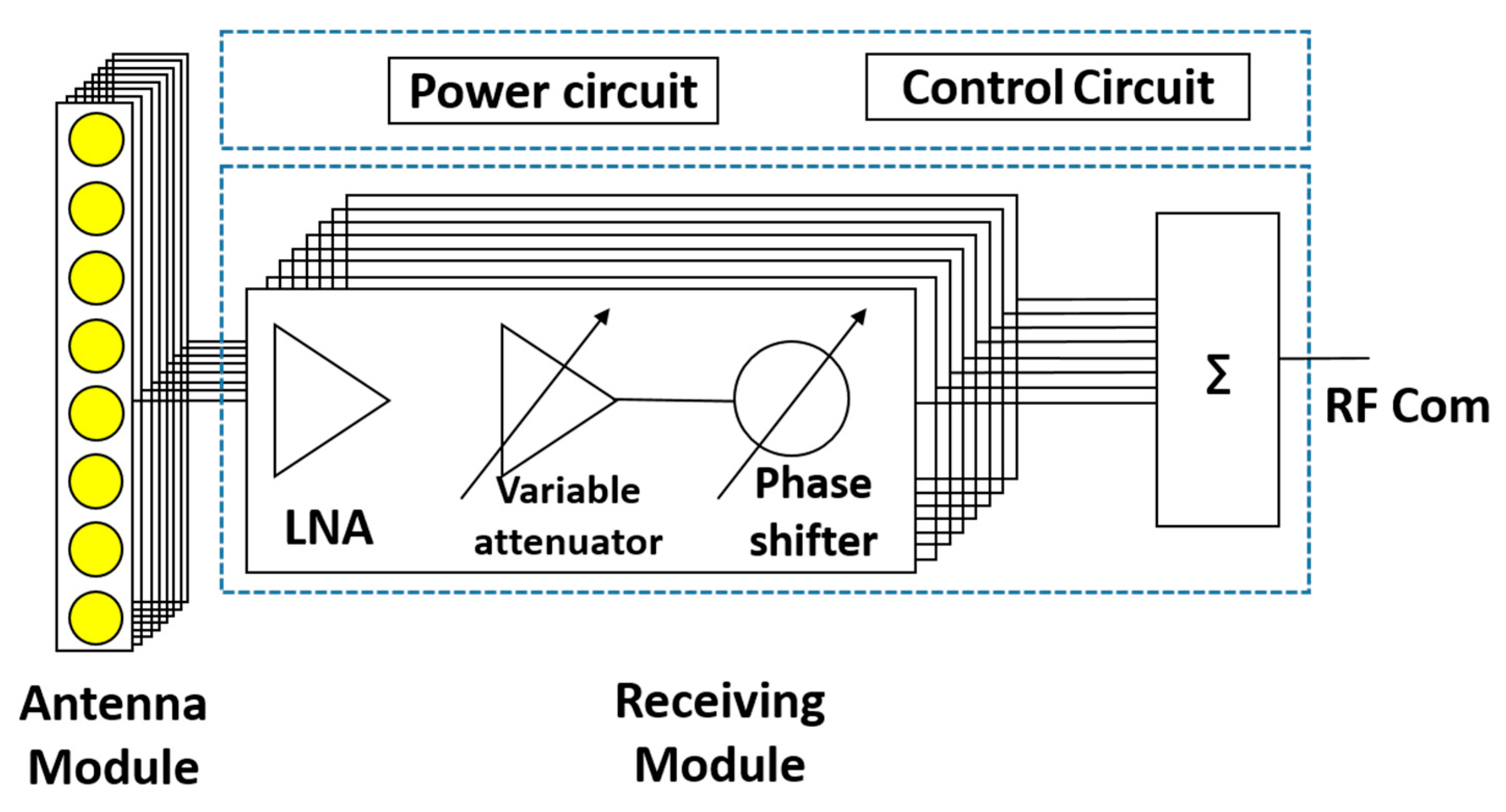
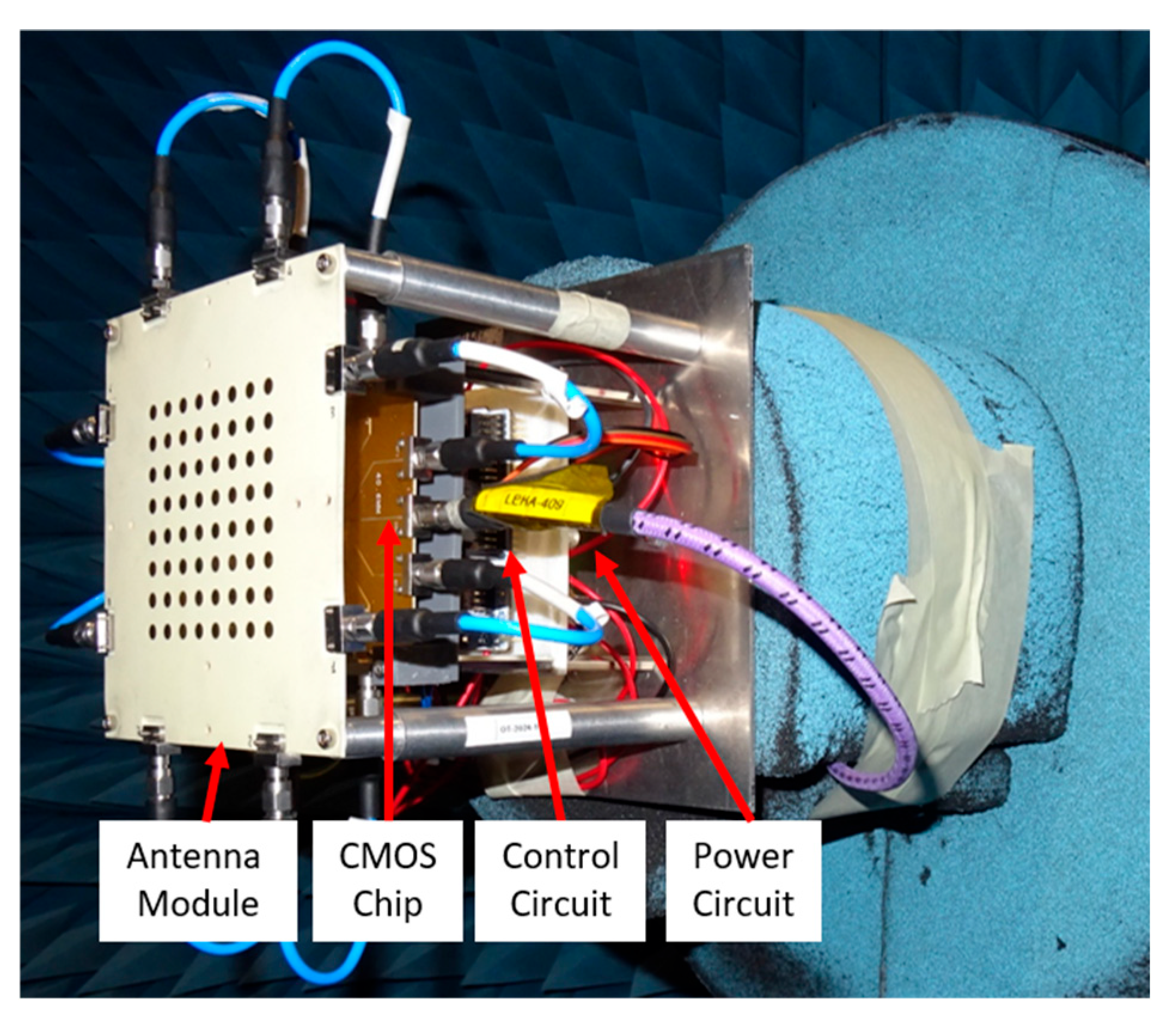

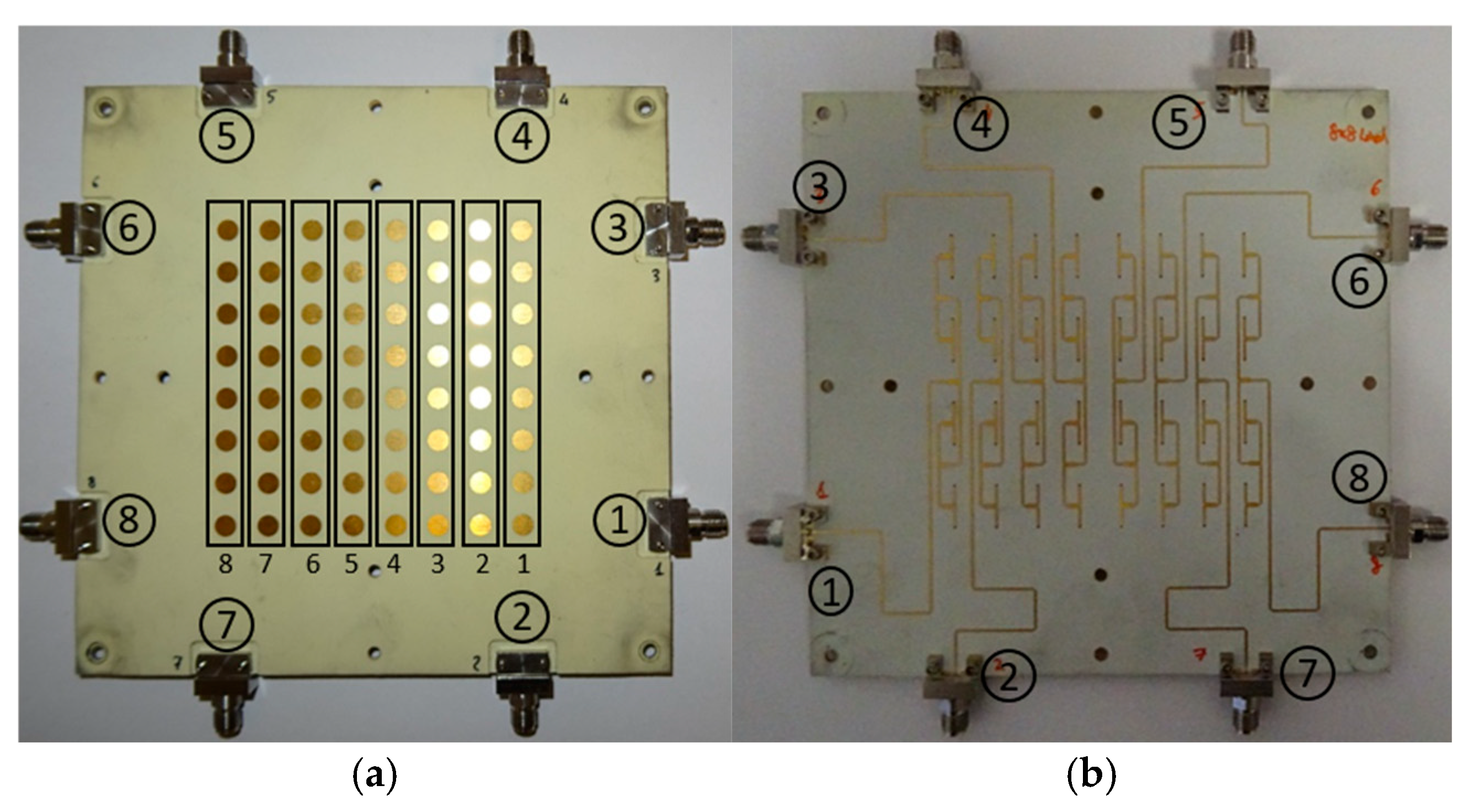
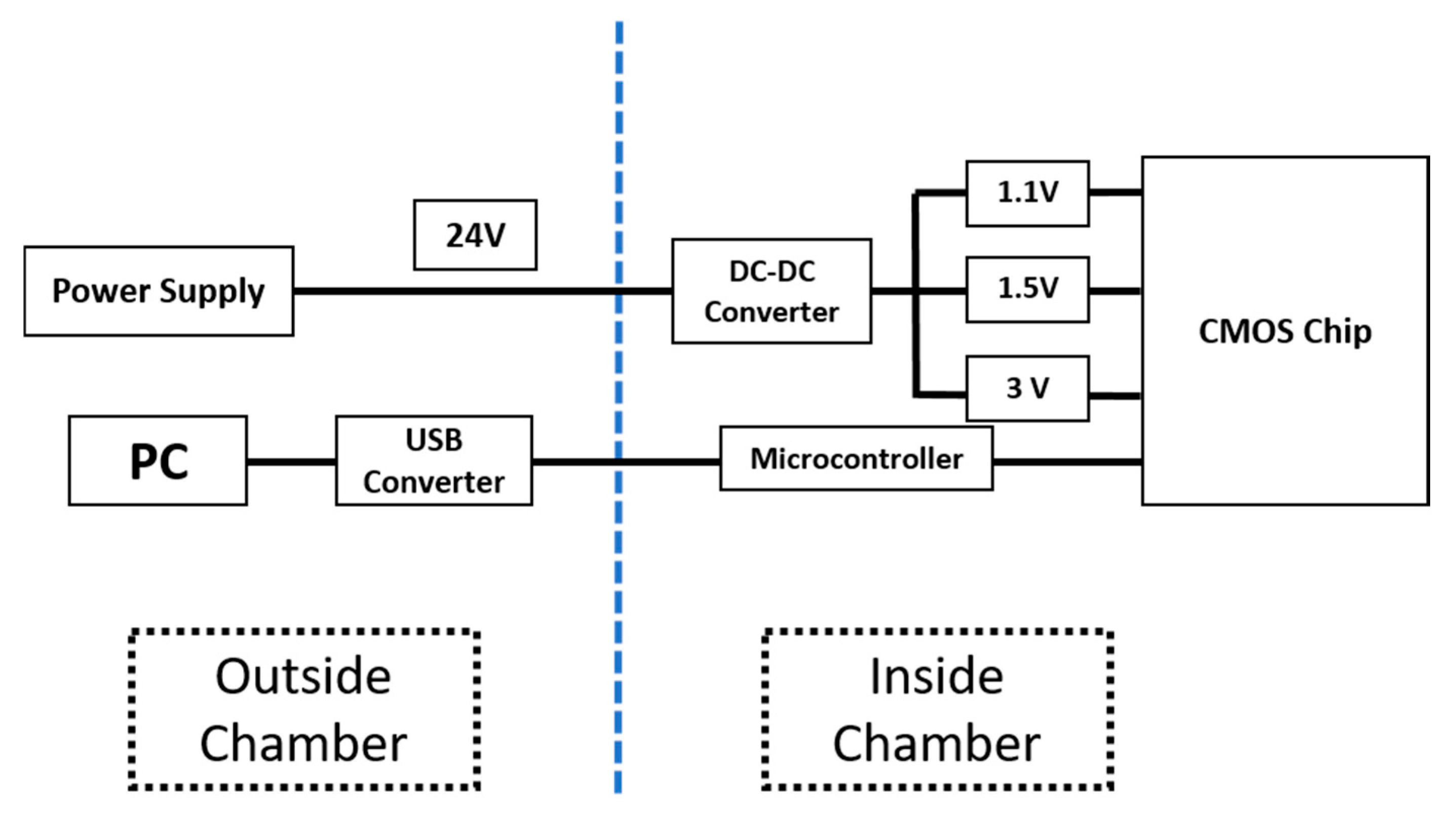
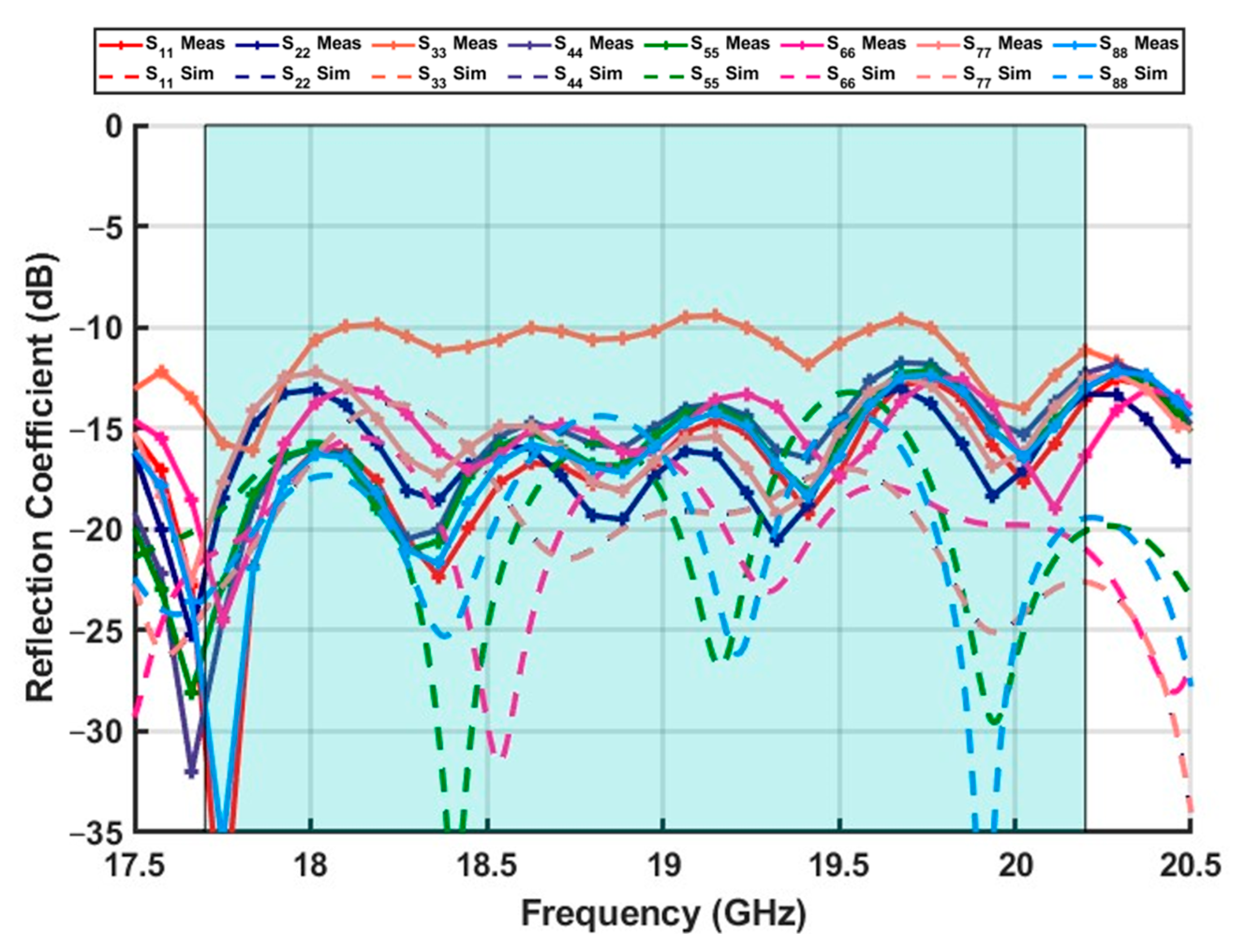

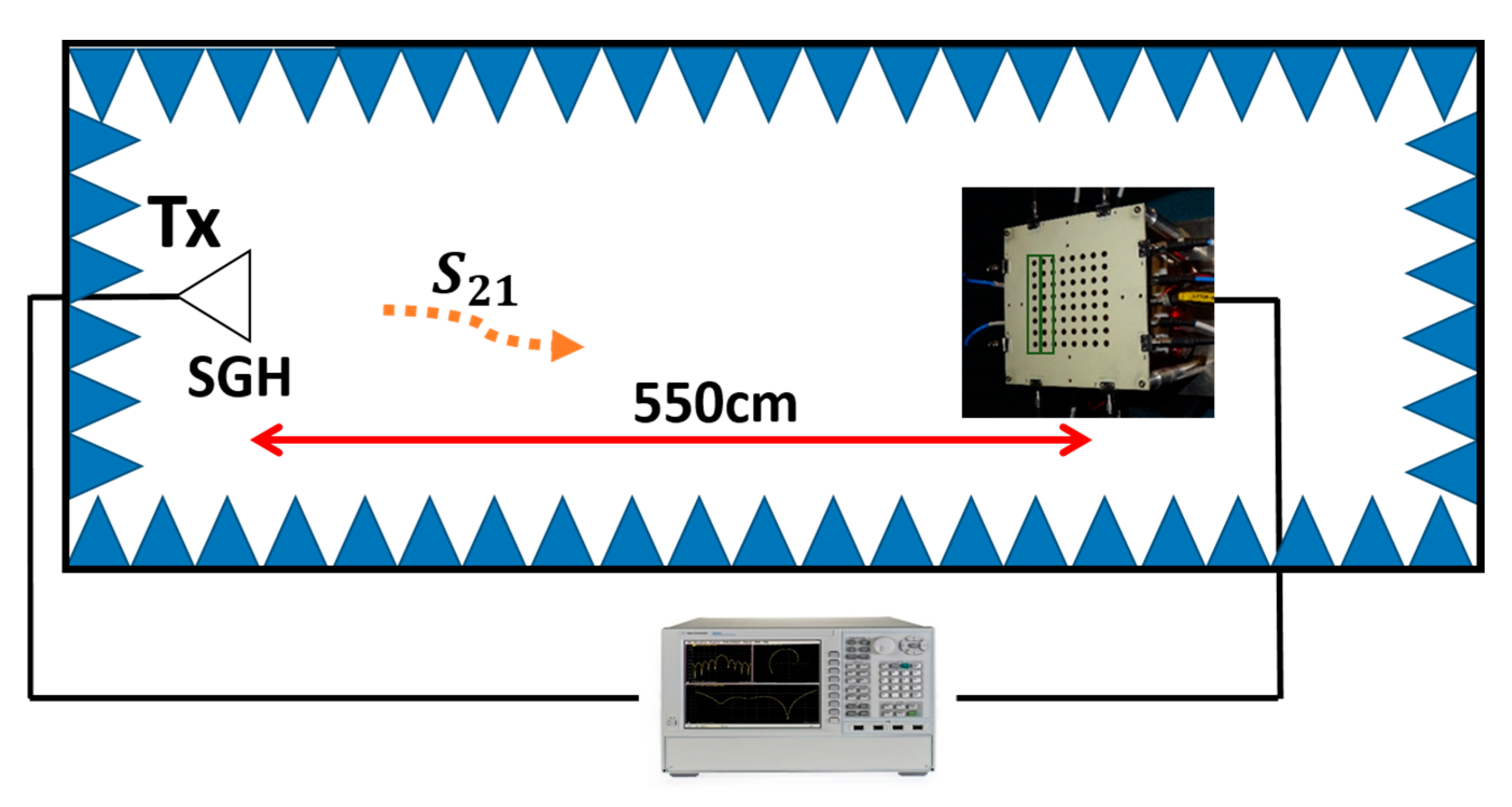

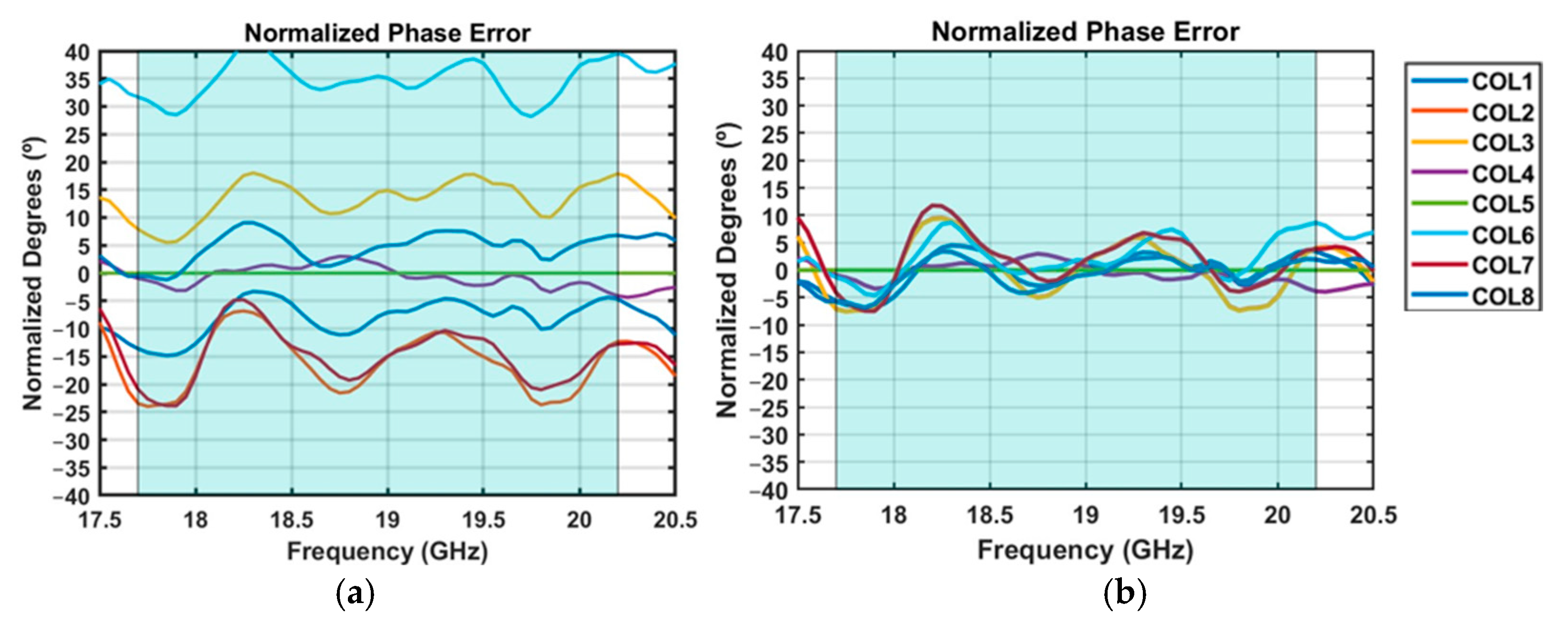
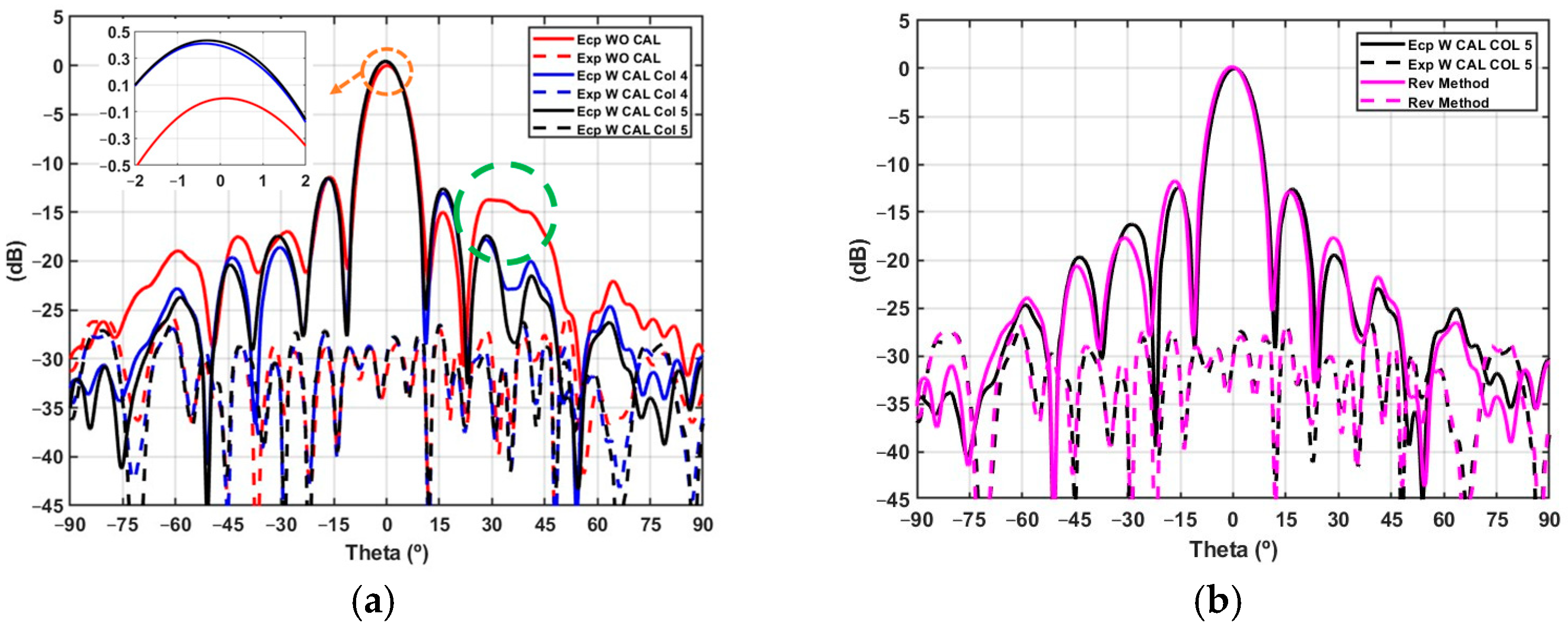


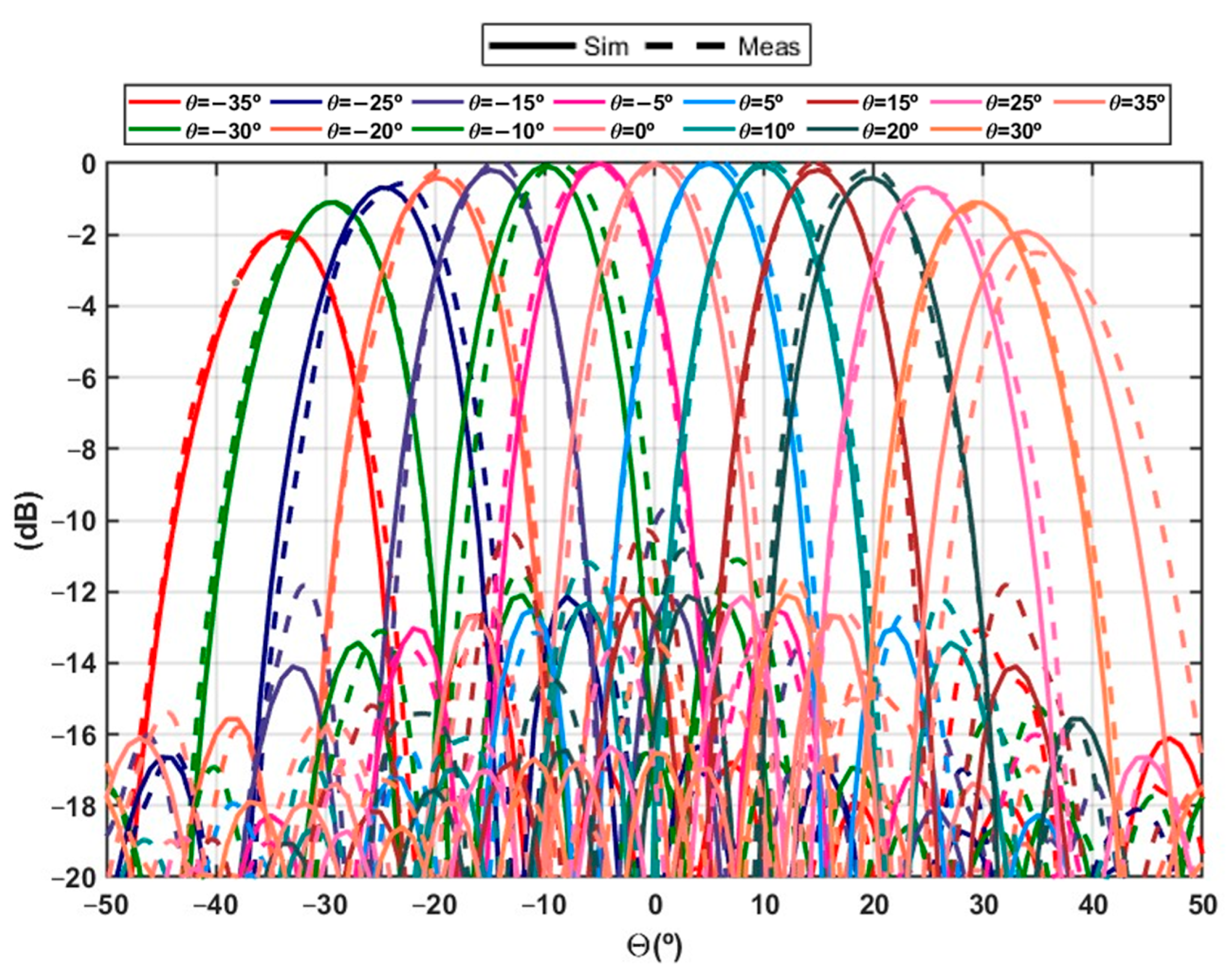
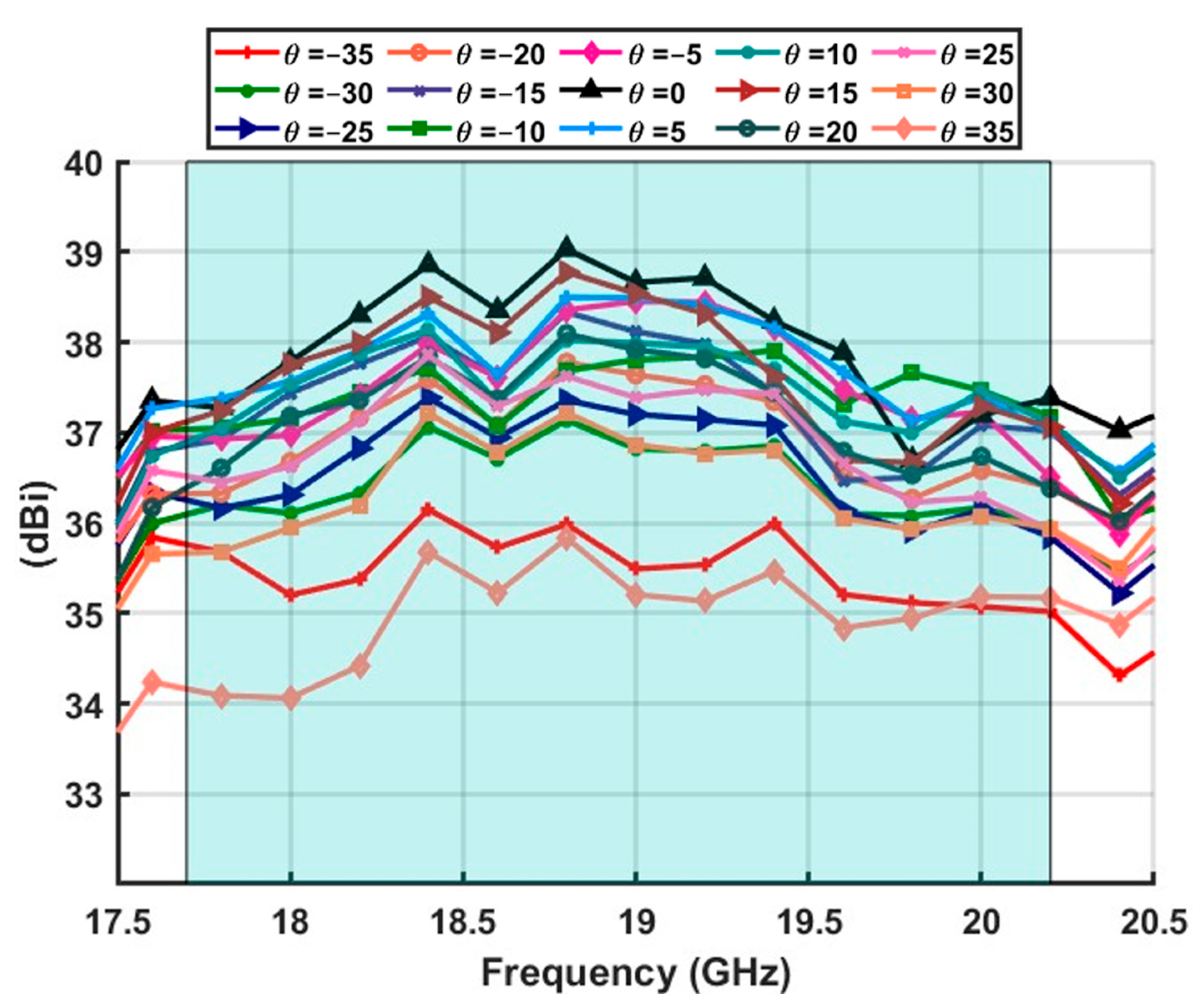
Disclaimer/Publisher’s Note: The statements, opinions and data contained in all publications are solely those of the individual author(s) and contributor(s) and not of MDPI and/or the editor(s). MDPI and/or the editor(s) disclaim responsibility for any injury to people or property resulting from any ideas, methods, instructions or products referred to in the content. |
© 2025 by the authors. Licensee MDPI, Basel, Switzerland. This article is an open access article distributed under the terms and conditions of the Creative Commons Attribution (CC BY) license (https://creativecommons.org/licenses/by/4.0/).
Share and Cite
Sun, X.; Calatayud-Maeso, J.; Muriel-Barrado, A.-T.; Fernández-González, J.-M.; Sierra-Castañer, M. Calibration of a Low-Cost 8×8 Active Phased Array Antenna. Appl. Sci. 2025, 15, 4066. https://doi.org/10.3390/app15074066
Sun X, Calatayud-Maeso J, Muriel-Barrado A-T, Fernández-González J-M, Sierra-Castañer M. Calibration of a Low-Cost 8×8 Active Phased Array Antenna. Applied Sciences. 2025; 15(7):4066. https://doi.org/10.3390/app15074066
Chicago/Turabian StyleSun, Xiaoliang, Jorge Calatayud-Maeso, Alfonso-Tomás Muriel-Barrado, José-Manuel Fernández-González, and Manuel Sierra-Castañer. 2025. "Calibration of a Low-Cost 8×8 Active Phased Array Antenna" Applied Sciences 15, no. 7: 4066. https://doi.org/10.3390/app15074066
APA StyleSun, X., Calatayud-Maeso, J., Muriel-Barrado, A.-T., Fernández-González, J.-M., & Sierra-Castañer, M. (2025). Calibration of a Low-Cost 8×8 Active Phased Array Antenna. Applied Sciences, 15(7), 4066. https://doi.org/10.3390/app15074066






